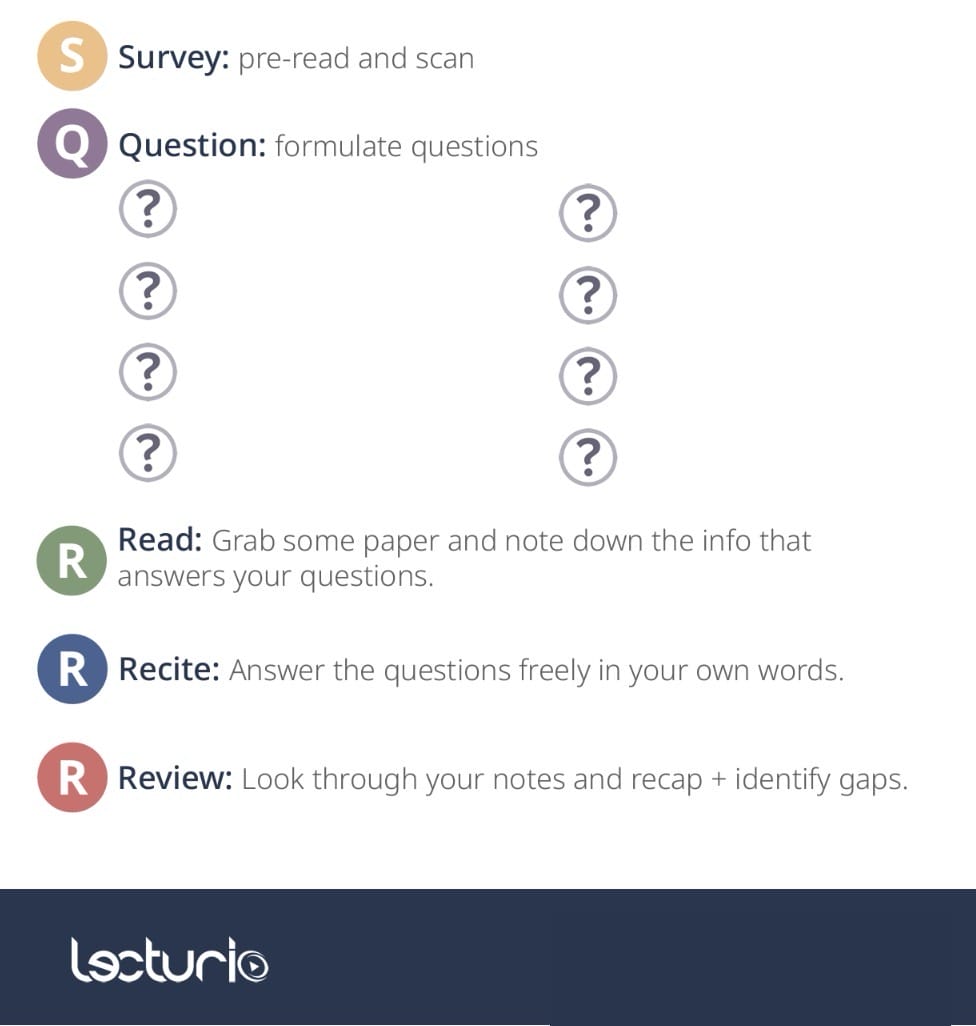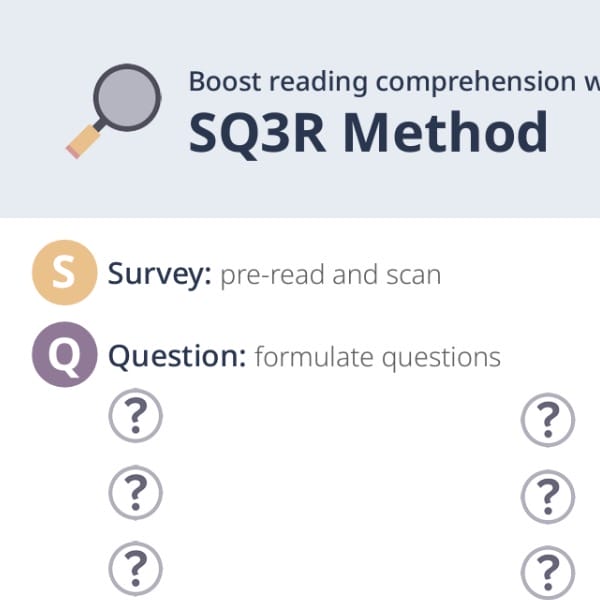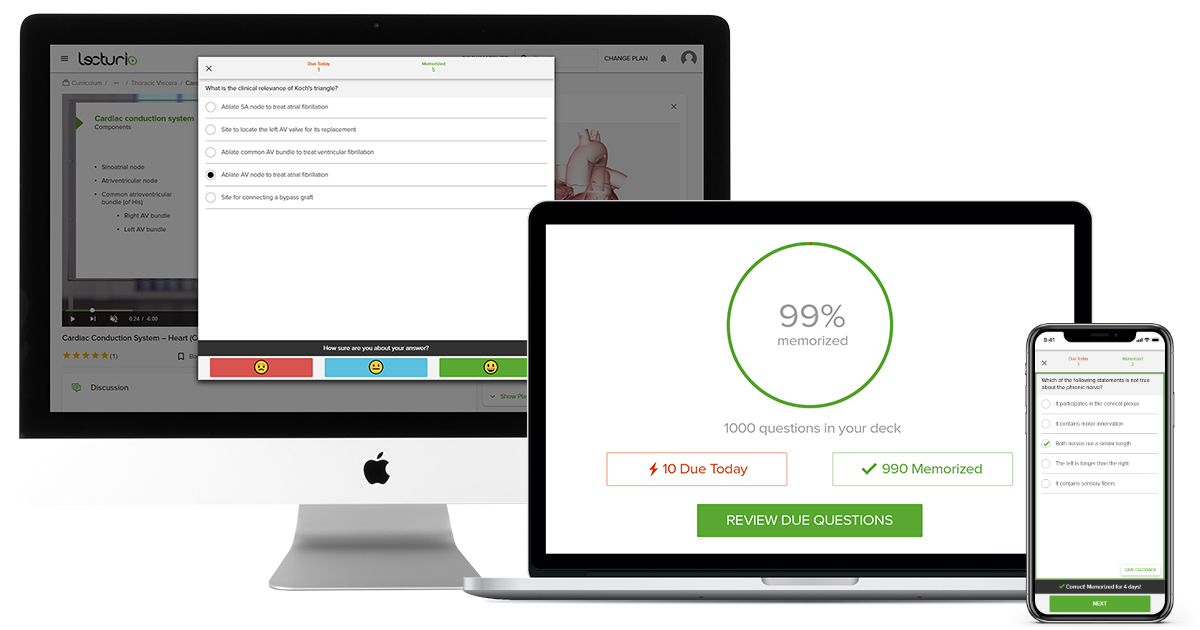What is the SQ3R method?
The SQ3R study method (or SQRRR method) is a study method focused on optimizing reading comprehension. It was developed by educational psychologist Francis P. Robinson in his book Effective Study.
What does SQ3R stand for?
SQ3R stands for:
- S: Survey
- Q: Question
- R (x3):
- Read
- Recite
- Review
Steps
- [SURVEY] The first step is pre-reading, scanning the text. Don’t dive in immediately – note the headings, subheadings, graphs, tables, and summary paragraphs first. What stands out to you? Try to get the gist of the chapter or topic without actually reading it in its entirety yet. This should only take about 3–5 minutes.
- [QUESTION] Create a set of questions about the topic. Headings and summary paragraphs especially can help you come up with questions, but also looking at images. The questions should be suitable to test your knowledge of the topic as a whole.
- [READ] Now, start reading in depth. While reading, you focus on the information that best relates to your questions, and write it down. Take care to not simply copy suitable parts, but rephrase the information from the text to answer your questions yourself.
- [RECITE] When you’re done reading and answering questions, try to reproduce the information freely. You can do this by reading out loud and rephrasing the questions and answers (maybe using the Feynman method). This relies on the learning principle of active recall: It is proven that testing yourself and actively retrieving information you’ve learned helps you retain the information better.
- [REVIEW] Repeat back to yourself what the point of the session was. Look back at your notes and review your learning objectives. What did you learn? What are your weaker areas or gaps that may need more practice? Repeat the reciting and other ways of reviewing your notes regularly (applying the principle of spaced repetition).
Tip: If you study with Lecturio, the platform does part of this for you. Each lesson comes with a set of learning objectives. You can use these to formulate your own questions. After each video, you additionally get asked quiz questions based on the learning objectives. Try Lecturio for free →
How does SQ3R work as a reading strategy?
Trying to answer your questions while reading is an example of active reading. Passive reading would mean to read without engaging with the study material, which often means the information does not fully “sink in.”
Applying what you read to your questions and putting it into context immediately makes you do an active task while taking in the text, which makes the information stick and forces you to truly understand what you read.
Variation 1: the SQ4R method
The SQ4T method adds a fourth “R,” and there are different variations out there. A common one is to add the step “Relate” or “Reflect” after the Review step. This involves placing what you learned in the study session into context with things you already previously knew. How will you use this new information? Where does it answer questions you previously had, and where does it form new connections and deeper understanding?
Variation 2: the PQRST method
The PQRST method includes the steps:
- Preview
- Question
- Read
- Summary
- Test
The first three steps are essentially the same as in the SQ3R method. The “Summary” and “Test” steps can be viewed as a split-up variation of the “Recite” step in the SQ3R method: You first summarize the material with notes, diagrams, mnemonics etc, and then turn back to your questions, testing yourself.
SQ3R example: study heart failure with SQ3R
Use your preferred book, resource, or Lecturio’s Concept Page on heart failure.
1. Survey
Begin by skimming the article. Note the headings, any bold terms, diagrams, and charts. This will provide an overview of key sections such as etiology, pathophysiology, signs and symptoms, diagnostic criteria, treatment options, and patient care.
2. Question
Convert these headings into questions to guide your detailed reading. For example:
- How common is heart failure?
- Which underlying conditions can cause heart failure, and how?
- What are the typical signs and symptoms?
- How is heart failure diagnosed?
- What treatment options are available for heart failure – acute and long-term?
- What’s the prognosis and what are possible complications?
3. Read
Read the text carefully to find answers to your questions. Focus on understanding how heart failure develops (pathophysiology), how it affects the body, and the principles behind its management. Make notes on the margins or in a notebook about the key points related to each question.
4. Recite
Without looking at your notes or the book, try to summarize the answers to each question. For example, recite the pathophysiology of heart failure, explaining how impaired cardiac pumping leads to fluid congestion and the impact on organs. Discuss the diagnostic tests used like ECGs and the roles of medications such as ACE inhibitors in treatment.
5. Review
Go back to your text and notes to check your accuracy and reinforce the material. This review helps solidify your memory and understanding. Try integrating this knowledge with related cardiovascular conditions or considering clinical scenarios where you might need to apply this information.
Free Download: SQ3R template

Free Download: SQ3R Template
Download the PDF and use it as a guide to start a reading session with the SQ3R method.





